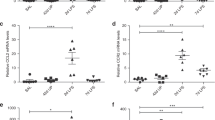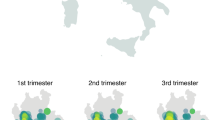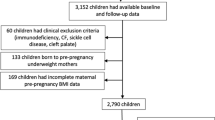Abstract
New information is emerging concerning the influence of environmental factors (e.g., viruses, pollutants, nutrients) on fetal lung development and the prenatal modulation of cellular and molecular effectors essential to the control of airway function, which may shed new light into the pathogenesis of chronic obstructive pulmonary disease in childhood. In particular, recent studies have shown that nanosize biological and inorganic particles (e.g., respiratory viruses and pollutants) are able to spread hematogenously across the placenta from mother to offspring and interfere with lung development during critical “windows of opportunity”. Furthermore, the nutritional balance of maternal diet during pregnancy can affect postnatal lung structure and function. Adverse prenatal environmental conditions can predispose to increased airway reactivity by inducing aberrant cholinergic innervation of the respiratory tract, enhanced contractility of the airway smooth muscle, and impaired innate immunity. Such changes can persist long after birth and might provide a plausible explanation to the development of chronic airway dysfunction in children, even in the absence of atopic predisposition. Insight into maternal−fetal interactions will contribute to a better understanding of the pathogenesis of highly prevalent diseases like bronchiolitis and asthma, and may lead to more precise preventative and therapeutic strategies, or new indications for existing ones.
Similar content being viewed by others
Log in or create a free account to read this content
Gain free access to this article, as well as selected content from this journal and more on nature.com
or
References
Jobe, A. H. Mechanisms of lung injury and bronchopulmonary dysplasia. Am. J. Perinatol. 33, 1076–1078 (2016).
Viscardi, R. M. & Kallapur, S. G. Role of Ureaplasma respiratory tract colonization in BPD pathogenesis: current concepts and update. Clin. Perinatol. 42, 719–738 (2015).
Shi, T., McAllister, D. A. O’Brien, K. L., Simoes, E. A., Madhi, S. A. et al. RSV Global Epidemiology Network. Global, regional, and national disease burden estimates of acute lower respiratory infections due to respiratory syncytial virus in young children in 2015: a systematic review and modelling study. Lancet 390, 946–958 (2017).
Piedimonte, G., Walton, C. & Samsell, L. Vertical transmission of respiratory syncytial virus modulates pre- and postnatal innervation and reactivity of rat airways. PLoS ONE 8, e61309 (2013).
Brown, P. M., Harford, T. J., Agrawal, V., Belkadi, A., Yen-Lieberman, B. et al. Prenatal exposure to respiratory syncytial virus alters postnatal immunity and airway smooth muscle contractility during early-life reinfections. PLoS ONE 12, e0168786 (2017).
Piedimonte, G. & Perez, M. K. Alternative mechanisms for respiratory syncytial virus (RSV) infection and persistence: could RSV be transmitted through the placenta and persist into developing fetal lungs? Curr. Opin. Pharm. 16, 82–88 (2014).
Manti, S., Cuppari, C., Lanzafame, A., Salpietro, C., Leonardi, S. et al. Vertical transmission of respiratory syncytial virus infection in humans. Pediatr. Pulmonol. 52, E81–84 (2017).
Rezaee, F., Gibson, L. F., Piktel, D., Othumpangat, S. & Piedimonte, G. Respiratory syncytial virus infection in human bone marrow stromal cells. Am. J. Respir. Cell Mol. Biol. 45, 277–286 (2011).
Othumpangat, S., Walton, C. & Piedimonte, G. MicroRNA-221 modulates RSV replication in human bronchial epithelial cells by targeting NGF expression. PLoS ONE 7, e30030 (2012).
Rezaee, F. et al. cAMP-dependent activation of protein kinase A attenuates respiratory syncytial virus-induced human airway epithelial barrier disruption. PLoS ONE 12, e0181876 (2017).
Harford, T. J., Rezaee, F., Scheraga, R. G., Olman, M. A. & Piedimonte, G. Asthma predisposition and respiratory syncytial virus infection modulate transient receptor potential vanilloid 1 function in children’s airways. J. Allergy Clin. Immunol. 141, 414–416 (2018).
Caterina, M. J. et al. The capsaicin receptor: a heat-activated ion channel in the pain pathway. Nature 389, 816–824 (1997).
Inoue, K. et al. Functional vanilloid receptors in cultured normal human epidermal keratinocytes. Biochem. Biophys. Res. Commun. 291, 124–129 (2002).
Scotland, R. S., Chauhan, S., Davis, C., De Felipe, C., Hunt, S. et al. Vanilloid receptor TRPV1, sensory C-fibers, and vascular autoregulation: a novel mechanism involved in myogenic constriction. Circ. Res. 95, 1027–1034 (2004).
Seki, N. et al. Expression and localization of TRPV1 in human nasal mucosa. Rhinology 44, 128–134 (2006).
Zhang, F., Yang, H., Wang, Z., Mergler, S., Liu, H. et al. Transient receptor potential vanilloid 1 activation induces inflammatory cytokine release in corneal epithelium through MAPK signaling. J. Cell Physiol. 213, 730–739 (2007).
Reilly, C. A. et al. Capsaicinoids cause inflammation and epithelial cell death through activation of vanilloid receptors. Toxicol. Sci. 73, 170–181 (2003).
Groneberg, D. A., Niimi, A., Dinh, Q. T., Cosio B., Hew M. et al. Increased expression of transient receptor potential vanilloid-1 in airway nerves of chronic cough. Am. J. Respir. Crit. Care Med. 170, 1276–1280 (2004).
Yu, H., Li, Q., Zhou, X., Kolosov, V. P. & Perelman, J. M. Transient receptor potential vanilloid 1 receptors mediate acid-induced mucin secretion via Ca2+ influx in human airway epithelial cells. J. Biochem. Mol. Toxicol. 26, 179–186 (2012).
Lin, R. L., Hayes, D. Jr. & Lee, L. Y. Bronchoconstriction induced by hyperventilation with humidified hot air: role of TRPV1-expressing airway afferents. J. Appl. Physiol. 106, 1917–1924 (2009).
Hu, D. E., Easton, A. S. & Fraser, P. A. TRPV1 activation results in disruption of the blood-brain barrier in the rat. Br. J. Pharm. 146, 576–584 (2005).
Fonceca, A. M., Chopra, A., Levy, A., Noakes, P. S., Poh, M. W. et al. Infective respiratory syncytial virus is present in human cord blood samples and most prevalent during winter months. PLoS ONE 12, e0173738 (2017).
World Health Organization. Ambient Air Pollution: A Global Assessment of Exposure and Burden of Disease (2016).
Horne, B. D., Joy, E. A., Hofmann, M. G., Gesteland, P. H., Cannon, J. B. et al. Short-term elevation of fine particulate matter air pollution and acute lower respiratory infection. Am. J. Respir. Crit. Care Med. 198, 759–766 (2018).
Oberdorster, G. Pulmonary effects of inhaled ultrafine particles. Int. Arch. Occup. Environ. Health 74, 1–8 (2001).
Baldauf, R. W., Devlin, R. B., Gehr, P., Giannelli, R., Hassett-Sipple, B., et al. Ultrafine particle metrics and research considerations: review of the 2015 UFP workshop. Int. J. Environ. Res. Public Health 13, 1054 (2016).
Xia, T., Kovochich, M., Brant, J., Hotze, M., Sempf, J., et al. Comparison of the abilities of ambient and manufactured nanoparticles to induce cellular toxicity according to an oxidative stress paradigm. Nano Lett. 6, 1794–1807 (2006).
Sun, D., Meng, T. T., Loong, T. H. & Hwa, T. J. Removal of natural organic matter from water using a nano-structured photocatalyst coupled with filtration membrane. Water Sci. Technol. 49, 103–110 (2004).
Shieh, K. J. et al. Antibacterial performance of photocatalyst thin film fabricated by defection effect in visible light. Nanomedicine 2, 121–126 (2006).
Chen, D. L. & Schuster, D. P. Imaging pulmonary inflammation with positron emission tomography: a biomarker for drug development. Mol. Pharm. 3, 488–495 (2006).
Grassian, V. H., O’Shaughnessy, P. T., Adamcakova-Dodd, A., Pettibone, J. M. & Thorne, P. S. Inhalation exposure study of titanium dioxide nanoparticles with a primary particle size of 2 to 5 nm. Environ. Health Perspect. 115, 397–402 (2007).
Scuri, M., Chen, B. T., Castranova, V., Reynolds, J. S., Johnson, V. J. et al. Effects of titanium dioxide nanoparticle exposure on neuroimmune responses in rat airways. J. Toxicol. Environ. Health 73, 1353–1369 (2010).
Othumpangat, S., Gibson, L. F., Samsell, L. & Piedimonte, G. NGF is an essential survival factor for bronchial epithelial cells during respiratory syncytial virus infection. PLoS ONE 4, e6444 (2009).
Liang, X. H., Jackson, S. Seaman, M., Brown, K., Kempkes, B., et al. Induction of autophagy and inhibition of tumorigenesis by beclin 1. Nature 402, 672–676 (1999).
Yue, Z., Jin, S., Yang, C., Levine, A. J. & Heintz, N. Beclin 1, an autophagy gene essential for early embryonic development, is a haploinsufficient tumor suppressor. Proc. Natl Acad. Sci. USA 100, 15077–15082 (2003).
Heinzerling, A., Hsu, J. & Yip, F. Respiratory health effects of ultrafine particles in children: a literature review. Water Air Soil Pollut. 227, https://doi.org/10.1007/s11270-015-2726-6 (2016).
Kulvietis, V., Zalgeviciene, V., Didziapetriene, J. & Rotomskis, R. Transport of nanoparticles through the placental barrier. Tohoku J. Exp. Med. 225, 225–234 (2011).
Wick, P., Malek, A. Manser, P., Meili, D., Maeder-Althaus, X. et al. Barrier capacity of human placenta for nanosized materials. Environ. Health Perspect. 118, 432–436 (2010).
Enders, A. C. & Blankenship, T. N. Comparative placental structure. Adv. Drug Deliv. Rev. 38, 3–15 (1999).
Fournier, S. B., D’Errico, J. N. & Stapleton, P. A. Engineered nanomaterial applications in perinatal therapeutics. Pharm. Res. 130, 36–43 (2018).
Yin, F. et al. A 3D human placenta-on-a-chip model to probe nanoparticle exposure at the placental barrier. Toxicol. Vitr. 54, 105–113 (2019).
Stapleton, P. A., Hathaway, Q. A., Nichols, C. E., Abukabda, A. B., Pinti, M. V., et al. Maternal engineered nanomaterial inhalation during gestation alters the fetal transcriptome. Part Fibre Toxicol. 15, 3 (2018).
Paul, E., Franco-Montoya, M. L., Paineau, E., Angeletti, B., Vibhushan, S. et al. Pulmonary exposure to metallic nanomaterials during pregnancy irreversibly impairs lung development of the offspring. Nanotoxicology 11, 484–495 (2017).
Lavigne, E., Donelle, J., Hatzopoulou, M., Van Ryswyk, K., Van Donkelaar, A., et al. Spatiotemporal variations in ambient ultrafine particles and the incidence of childhood asthma. Am. J. Respir. Crit. Care Med. 199, 1487–1495 (2019).
Yusuf, S., Piedimonte, G., Auais, A., Demmler, G., Krishnan, S., et al. The relationship of meteorological conditions to the epidemic activity of respiratory syncytial virus. Epidemiol. Infect. 135, 1077–1090 (2007).
Cottrell, L., Neal, W., Ice, C., Perez, M. K. & Piedimonte, G. Metabolic abnormalities in children with asthma. Am. J. Respir. Crit. Care Med. 183, 441–448 (2011).
Griffiths, P., Walton, C., Samsell, L., Perez, M. K. & Piedimonte, G. Maternal high-fat diet in pregnancy results in metabolic and respiratory abnormalities in offspring. Pediatr. Res. 79, 278–286 (2016).
Brigham, E. P., Woo, H., McCormack, M., Rice, J., Koehler, K. et al. Omega-3 and omega-6 intake modifies asthma severity and response to indoor air pollution in children. Am. J. Respir. Crit. Care Med. 199, 1478–1486 (2019).
Barker, D. J. & Thornburg, K. L. The obstetric origins of health for a lifetime. Clin. Obstet. Gynecol. 56, 511–519 (2013).
Acknowledgements
The authors are very grateful to the National Heart, Lung and Blood Institute of the National Institute of Health and the Cystic Fibrosis Foundation for the generous support of some of the research described in this article over the past 20 years. We also thank Dr. Caroline Smallcombe for helping with the preparation of the figures. This work was supported in part by NIH-NHLBI grant RO1HL061007 (G.P.) and Cystic Fibrosis Foundation grant PIEDIM16G0 (G.P.). The funders had no role in study design, data collection and interpretation, or the decision to submit the work for publication.
Author information
Authors and Affiliations
Contributions
G.P. and T.J.H. co-wrote the manuscript. G.P. responded to the reviewer’s critiques.
Corresponding author
Ethics declarations
Competing interests
The authors declare no competing interests.
Additional information
Publisher’s note Springer Nature remains neutral with regard to jurisdictional claims in published maps and institutional affiliations.
Supplementary information
Rights and permissions
About this article
Cite this article
Piedimonte, G., Harford, T.J. Effects of maternal−fetal transmission of viruses and other environmental agents on lung development. Pediatr Res 87, 420–426 (2020). https://doi.org/10.1038/s41390-019-0657-4
Received:
Revised:
Accepted:
Published:
Issue date:
DOI: https://doi.org/10.1038/s41390-019-0657-4



